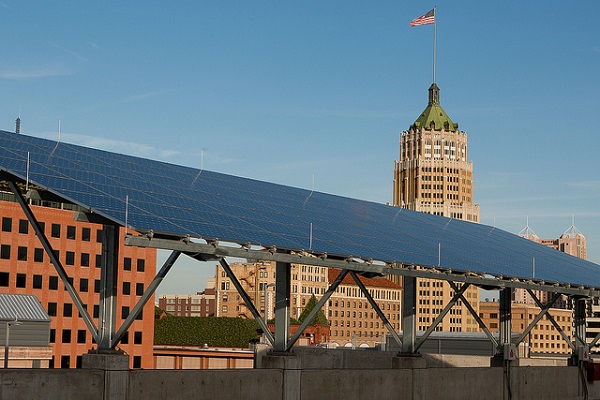It’s the utilities vs. rooftop solar and with PV becoming more accessible and installations soaring, the fight is heating up.
In San Antonio, the municipally owned CPS Energy last week said it will slash the value of the credit for solar produced from rooftop installations. The company’s claim is a central one made by the utilities: that as more people produce their own power through rooftop solar – and reduce their electricity bills – companies are left unable to meet their cost of maintaining the energy infrastructure. CPS Energy said it had two options: reduce the amount it credits solar households for rooftop-produced solar, or raise rates for everyone.

Now, power company fears about distributed solar aren’t new – investor-owned utilities in California have long fought to temper net metering and community solar, for instance. But the issue is top of mind now amid widespread discussion of a report [PDF] by the utility trade association Edison Electric Institute that said solar photovoltaics – along with battery storage, fuel cells, geothermal energy systems, wind, micro turbines, and electric vehicle (EV) enhanced storage – “could threaten the centralized utility model.”
CPS Energy seemed to waste little time in moving to keep the upper hand. Here’s how Cris Eugster, executive vice president and chief strategy and technology officer for the company, explained the company’s move, in a statement:
Costs to install photovoltaic systems continue to fall, making them increasingly available for more customers. And with that growth, the costs of the utility infrastructure are borne by fewer customers—those who don’t have solar systems. To ensure that solar customers continue to enjoy the benefits of any distributed energy they produce, and pay a fair share of the infrastructure that they rely on, we’re taking a different approach. This is really important in San Antonio, where one quarter of the community’s residents are at or below the poverty level, and monthly energy bills absorb a larger portion of their monthly budgets.
But not everyone is buying that solar is putting such a squeeze on CPS Energy. Lanny Sinkin, executive director of the advocacy group Solar San Antonio, told Texas Public Radio that the company’s customers don’t have anywhere near enough solar to present a cost-structure issue.
“In San Antonio, we have about 8 megawatts of solar distributed in a system that’s more than 7000 megawatts,” Sinkin said.
As it stands today, CPS Energy credits customers at the retail rate for any rooftop solar production. That’s now amounts to 9.9 cents per kilowatt-hour. The company proposes replacing that with a “SunCredit” of 5.6 cents/kWh beginning in November. The company says this rate takes into account the cost of poles, wires, substations and the like – things that all customers, even those who produce more solar than their total power usage, rely upon.
Solar advocates have argued that this sort of raw accounting ignores the benefits that distributed solar brings: reduced pollution and expenses for conventional power; less need for new investment in transmission and distribution; reduced transmission losses; and reduced costs of meeting renewable energy standards.
The California pro-solar group Vote Solar Initiative earlier this year released a report that called utility cost claims for net metering inflated, and said that once the 5 percent net-metering cap is met in the state, non-solar ratepayers will benefit to the tune of a combined $92.2 million per year.
UPDATE: Readers should be sure to check out the comments below, including those from CPS Energy rep Lisa Lewis, which offer additional perspective on CPS Energy’s approach to solar. -PD